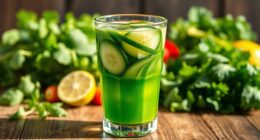A medium lemon usually gives you about 3 tablespoons of juice. If you've got a larger lemon, it can yield up to 4 tablespoons, which is nearly a quarter cup! Smaller lemons often only provide around 2 tablespoons. Keep in mind that juice yield can vary based on size, ripeness, and type of lemon. Want to know how to get the most juice out of your lemons? There are some handy tips you might find useful!
Key Takeaways
- A medium lemon typically yields about 3 tablespoons of juice.
- Larger lemons can yield up to 4 tablespoons, or about a quarter cup.
- Small lemons may only produce around 2 tablespoons of juice.
- On average, 5.25 to 5.5 medium lemons are needed for 1 cup of juice.
- Juice yield varies based on lemon size, ripeness, variety, and season.

When you're squeezing a lemon, you might wonder just how much juice you can expect from it. The answer varies quite a bit depending on the size of the lemon you're using. Typically, a medium lemon yields about 3 tablespoons of juice. If you're lucky enough to have larger lemons, you can get up to 4 tablespoons, which is about a quarter cup! So, if you've got a recipe that calls for a cup of lemon juice, you'll need around 5.25 to 5.5 medium lemons to get the right amount of juice.
But, you might be asking yourself, "How much juice can I really get from the lemons I have?" The juice yield can fluctuate based on a few factors, including the lemon's size, ripeness, variety, and even the season. For example, if you're dealing with very small lemons, you might only extract about 2 tablespoons of juice. Knowing these details can help you plan better when you're diving into your favorite lemon recipes.
If you're using a citrus squeezer, you can maximize the amount of juice you get from each lemon. Before you cut into your lemon, try warming it in the microwave for about 10-20 seconds. This little trick can help release even more juice. Rolling the lemon on the countertop is another effective way to increase your juice yield. Just apply a bit of pressure with your palm and roll it back and forth; you'll be amazed at how much easier it's to juice afterward.
Lemons are incredibly versatile and are often featured in a variety of recipes, from salad dressings to desserts. When you're preparing to make a dish that requires lemon juice, such as a zesty marinade or a refreshing lemonade, knowing how much juice you can expect from your lemons is crucial. It can save you from last-minute grocery runs and help ensure your dish turns out just right.
It's also important to keep in mind that different lemon varieties can produce varying amounts of juice. If you find yourself with a batch of juicy Meyer lemons, for instance, you might find they yield more juice than standard lemons. This variability can be a delightful surprise in your cooking adventures.
Frequently Asked Questions
How Much Bottled Lemon Juice Equals One Lemon?
When you're looking to substitute bottled lemon juice for fresh lemon juice, it's pretty simple.
You can use about 2 tablespoons of bottled juice to replace the juice from one medium lemon. This way, you'll maintain a similar flavor in your recipes.
Just keep in mind that bottled lemon juice might've different acidity levels, so always check the label for any additives that could affect the taste.
Enjoy your cooking!
How Much Juice for 1 Lemon?
When you're looking to extract juice from a lemon, the amount you get depends on the lemon's size. A medium lemon usually gives you about 3 tablespoons of juice, while a large one can yield around 4 tablespoons.
If you're using smaller lemons, expect about 2 tablespoons. To maximize your juice, roll the lemon on a hard surface before cutting. This simple trick can help you get every last drop!
How Much Are 2 Lemons Juiced?
Imagine two friends sharing a refreshing drink on a sunny day. When you juice two medium lemons, you'll get about 6 tablespoons, enough to brighten your beverage.
If you grab large lemons instead, you could squeeze out around ½ cup, making your drink even zestier.
Smaller lemons might yield only about 4 tablespoons, so it's wise to have a few extras handy.
Don't let a lack of juice spoil your sunny day!
Can I Use Bottled Lemon Juice Instead of Fresh Lemon?
You can use bottled lemon juice instead of fresh lemon, but keep in mind that the flavor might differ.
Bottled juice often contains preservatives and lacks the fresh taste and essential oils found in freshly squeezed lemons. If you're looking for convenience, it works, but for recipes where flavor is key, fresh juice is usually better.
Remember to check the label, as some brands dilute their product, which can affect the overall taste.
Conclusion
In conclusion, knowing how much lemon juice is in one lemon can really enhance your cooking and drinks. On average, you'll get about 2 to 3 tablespoons of juice from a medium lemon. That's enough to brighten up a whole batch of lemonade or give your favorite dish a zesty kick! Fun fact: just one lemon can provide around 30% of your daily vitamin C needs, making it a tasty and healthy addition to your meals!
Cindy thoroughly researches juicing trends, techniques, and recipes to provide readers with practical advice and inspiration. Her writing style is accessible, engaging, and designed to make complex concepts easy to understand. Cindy’s dedication to promoting the advantages of juicing shines through her work, empowering readers to make positive changes in their lives through the simple act of juicing.











